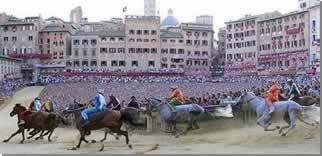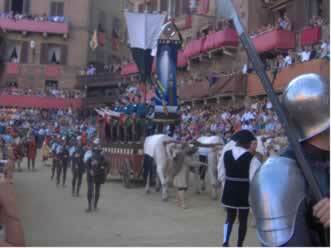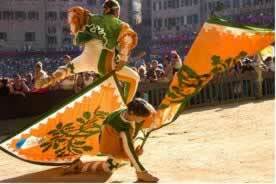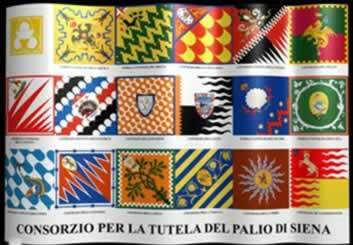In Brasile ci sono molte feste tradizionali eats: "Festa Junina" with festival in tutte le regioni del paese, "A Cavalgada" - Rio Grande del Sud, "Ox from Parintins" to Parintins - Amazonas ecc. In Italy it is stesso, the traditional way of eating: Il palio di Siena in Siena – Tuscany, La Partita a scacchi with personaggi I experienced Marostica – Vicenza ecc. Learn about the traditional festival is a way to get to know the population and its cultural identity. Allora, meet us in questo testo un po’ sul Palio di Siena. / In Brazil there are many traditional festivals such as: Festa Junina with celebration in all regions of the country, the Cavalgada - Rio Grande do Sul, Boi de Parintins, in Parintins - Amazonas etc. In Italy it's the same thing, there are traditional festivals like: ‘Il palio di Siena’ in Siena – Tuscany, ‘La partita a scacchi’ with live people in Marostica - Vincenza etc. We know that traditional festivals are a way to get to know the people and their cultural identity. So, you will know in this text a little about the ‘Palio di Siena’.
Curiosità: / Curiosity: Il film 007 – Quantum of Solace (2008 registers Marc Forster), è stato rotato alcune delle sue scene to Siena when Il Palio happened, this appariscono in it prime parti del film / The film 007 – Quantum of Solace (2008, director Marc Forster), had some of its scenes shot in Siena, when Il Palio happened, which appear in the first parts of the film.

La gara alla Piazza del Campo (see PALIO DELL'ASSUNTA 2010 ( http://www.youtube.com/watch? v=wzFNvSA0OtM&feature=related)/ The competition at Praça do Campo
Chi non sa la città di Siena is connoisseur dai suoi muri medievali and le sue strette vie. Questa gara succeeds due back all year, on 02 luglio (representing the Festeggio della Madonna di Provenzano) and on August 13 (representing the Festeggio dell'Assunta – sono 04 giorni di festa)./ For those who don't know, the city of Siena is known for its medieval walls and its narrow streets. This competition takes place twice a year, on July 2nd (representing the Madonna di Provenzano) and on August 13 (representing the celebration of Santa Maria Assunta - there are 4 days of party).
Cousin Palio a cavallo che c’è notizia Siena, ebbe disputed al 1644, and alcune regole che cerano in quellpocaepoca rimangono fino ai nostri giorni. If raccounts at 1729 Violante de Bavaria, Governatrice di Siena, to make the gara più interesting, there is a decision to divide the città in 17 parti (contrade) and che dovevan disputes the loro il Palio. And alla fine, al vicitore if it gave a drappo di arrow. / The first Palio on horseback that is known in Siena was disputed in 1644, and some rules that existed at that time remain until today. It is said that in 1729, Violante de Bavaria, Governor of Siena, to make the competition more interesting, decided to divide the city into 17 parts (“neighbourhoods”) and that they had to compete among them for the Palio. And at the end, the winner was given a piece of silk.
Do not stop now... There's more after the advertising ;)
Agreement col diionario Sabatini – Coletti la parola Palio means: “drappo the standardo, ricamato the dipinto, che in epoca medievale was given in prize al vincitore di una gara.” La parola palio viene dal latino and la prima returns che è stata usata fu al section XIV./ According to the Sabatini – Coletti dictionary the word Palio means: “piece or standard, embroidered or painted, which at the time Medieval was given as a prize to the winner of a competition.” The word palio comes from Latin and was used for the first time in the century XIV.
Il Palio is not solo la gara a cavalli, in verità, prima della gara enters Piazza il corteo di persone che rappresentano ogni contrade e anche i personaggi medievali, ci sono le bande tradizionali, il famous gioco delle bandiere and last enter il Carroccio che porta il Palio (della gara award), question is a train car from there buoi. / The Palio is not only the horse competition, in fact, before the competition, the procession of people representing each “neighborhood” and the characters enter the square. Medieval, they have the traditional bands, the famous game of flags and finally the ‘Carroccio’ that takes the Palio (competition prize), which is a cart pulled by oxen.
Vedi delle photo: / See some photos:
 (Il Carroccio)
(Il Carroccio)
 (Il gioco delle bandiere)
(Il gioco delle bandiere)
 (Le bandiere di ogni contrade)
(Le bandiere di ogni contrade)
Isabela Reis de Paula
Brazil School Collaborator
Graduated in Languages with Qualification in Portuguese and Italian
By the Federal University of Rio de Janeiro - UFRJ
Italian - Brazil School
Would you like to reference this text in a school or academic work? Look:
PAULA, Isabela Reis de. "Le feste tradizionali d'Italia: Il palio di Siena"; Brazil School. Available in: https://brasilescola.uol.com.br/italiano/le-feste-tradizionali-ditalia-il-palio-di-siena.htm. Accessed on June 29, 2021.



